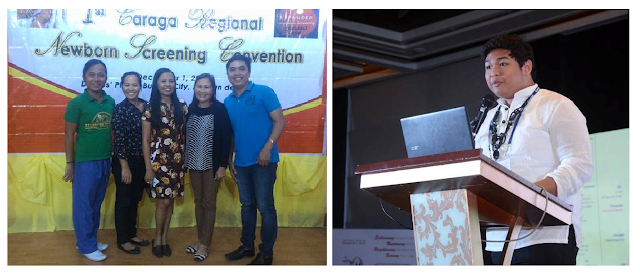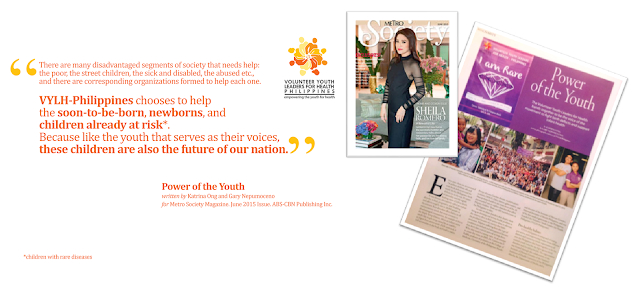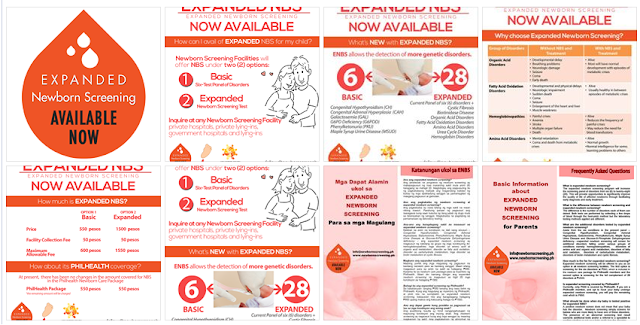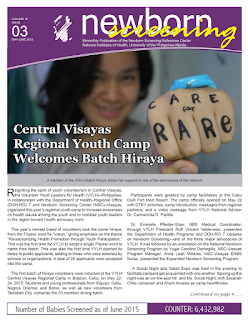Aside from the year-long advocacy activities conducted by volunteer youth leaders (VYLs) across the country, VYLH-Philippines took great strides in terms of volunteer recruitment, social involvement and social media campaigns this 2015. As the network strives to fulfill its goal of empowering the youth for health, VYLH-Philippines has also increased its presence on the national and regional level.
Youth camps and orientations were held in Central Visayas, National Capital Region, Cordillera Administrative Region, Central Luzon and CARAGA. These orientations were made possible through the assistance of the Department of Health Regional Offices (DOH III, VII, NCR, CAR, and CARAGA), and Newborn Screening Centers (NSC Central Luzon, NIH, Visayas and Mindanao). Starting from the Central Visayas Camp, new volunteer youth leaders were enlisted to our fifth batch dubbed as Batch Hiraya. Hiraya is a Filipino word for dream, imagination, or vision. This was the first time for VYLH-Philippines to adopt a single Filipino word for a batch name, and the first time the camp was opened to the public—augmenting those who were recommended by schools and organizations. These applicants were subjected to an application and screening procedure designed by the cluster.
Related:VYLH Central Visayas welcomes Batch Hiraya
Related:VYLH Central Visayas welcomes Batch Hiraya
VYLH in the Universities
Growing university networks continue to diversify throughout the country. In Northern Luzon, VYLH-Philippines was able to reach student leaders from Kalinga State College, University of Cordillera and Benguet State University through the help of DOH-CAR Regional Office.
The student network in UP Manila and Los Baños also showed progress. In UP Manila, a number of student organizations from different colleges and the College of Public Health Student Council have been active partners in activities conducted by the network in the campus, while in UP Los Baños, seven student organizations have already enlisted their support to VYLH-Philippines and its advocacies. During the first semester of AY 2015-2016, more than 300 students comprise the UP Los Baños network. The network is composed of the UPLB Genetics Society, UPLB Microbiological Society, UP Oikos, UP Community Broadcasters’ Society, UNESCO Club UPLB, Philippine Association of Nutrition Alpha-Omega Chapter, and Concordia Scientia Animalis.
 |
| UP Manila students joining VYLH-Philippines UP Manila activities (Photo: Shaila Bautista) and UP Los Baños students handling "I Care for Rare" placards for Rare Disease Week 2015 |
In Iloilo, NSC Visayas sponsored the first Students’ Forum on Expanded Newborn Screening and this was attended by student leaders coming from West Visayas State University, St. Paul’s University-Iloilo, Central Philippine University, University of San Agustin, and Iloilo Doctor’s College. In Cebu and Dumaguete, a VYLH-Philippines Advocacy Forum was held at the University of San Carlos and Collegio de Santa Catalina de Alejandria, while in Siquijor, VYLH-Philippines volunteers, together with the Supreme Student Government of Siquijor State College, conducted a school-wide Youth for Health Symposium and it was attended by SSC students and faculty.
In Butuan, VYLH-Philippines CARAGA volunteers conducted a forum on newborn screening and folic acid among the BS Radiologic Technology students of Asian College Foundation.
In Butuan, VYLH-Philippines CARAGA volunteers conducted a forum on newborn screening and folic acid among the BS Radiologic Technology students of Asian College Foundation.
Social Involvement
 |
| L to R: Mr. Floyd Edrea, Dr. Carmencita Padilla and Mr. Christian Emmanuel Enriquez |
VYLH-Philippines also participated in two events organized by the National Academy of Science and Technology (NAST), an agency under the Department of Science and Technology (DOST). These include the Roundtable Discussion on Folic Acidwherein the proposed legislation on folic acid supplementation and fortification was presented and the Science Legislative Forum on Rare Diseases in support of the Rare Disease Bill filed in Congress.
 |
| VYLH-Philippines participated in two NAST-organized events: (L) Roundtable Discussion on Folic Acid on July 23, 2015 and (R) Science Legislative Forum on Rare Diseases on September 2, 2015 |
As part of its efforts in promoting the network and its advocacies, VYLH-Philippines volunteers participated in various regional, national and international events. Volunteers were able to participate in this year’s Cordillera Youth Congress (January) and Global Youth Summit-Manila (March). The network also joined the NBS Orientation for NCR MAPEH (Music, Arts, Physical Education, and Health) Teachers (April) wherein a lecture on the role of the youth in NBS promotion and the need to integrate NBS in the Grade 8 MAPEH curriculum was given. VYLH-Philippines National President Mr. Christian Emmanuel Enriquez and CARAGA Regional Coordinator Mr. Anthony Torralba presented the role of the youth in health issues and the works of VYLH-Philippines volunteers at the 13th National Newborn Screening Convention (October) and First CARAGA Newborn Screening Convention (December), respectively.
Related: The Youth speaks for a healthier Philippines
On the other hand, NCR-South Luzon Cluster Coordinator Mr. Rufus Adducul presented the experience of the Institute of Human Genetics of NIH-UP Manila in organizing VYLH-Philippines and the achievements of the youth network during the first Colleges and Universities Public Service Conference (CUPSCon) organized by the University of the Philippines (November). Lastly, VYLH-Philippines was represented during the 12th Asian Congress of Nutrition (ACN) in Japan by Former National President Mr. Ryan Pascual. VYLH-Philippines also participated this year’s ACN poster presentations.
Related: IHG-NIH and VYLH highlight the Youth's Role in Health Promotion at CUPSCON
Related: The Youth speaks for a healthier Philippines
 |
| CARAGA Regional Coordinator Anthony Torralba (in blue) at the First CARAGA NBS Convention (L) and National President Christian Emmanuel Enriquez at the 13th National NBS Convention (R). |
Related: IHG-NIH and VYLH highlight the Youth's Role in Health Promotion at CUPSCON
 |
| VYLH-Philippines NCR-South Luzon Cluster Coordinator Rufus Adducul at CUPSCON (L) and Former National President Ryan Pascual (R) at the 12th ACN (R). |
 |
| DOH-Central Visayas NBS Fun Run |
 |
| VYLH-Philippines joined the Reunion of Saved Babies held in Dumaguete, Iloilo, Talisay, Cebu, Tagbilaran, Tacloban and Davao |
VYLH-Philippines volunteers and Newborn Screening Centers also participated in this year’s National Pregnant Women’s Day Celebration (Buntis Day) organized by the Philippine Obstetrical and Gynecological Society (POGS). The said event is held every March 10. Members from Manila, Los Baños, Lipa City, Cebu, Iloilo and Davao were able to participate in this national event. This year’s VYL participation is the biggest in four years. VYLH-Philippines has always been an active participant of the Buntis Day Celebration since 2012– the same year when POGS successfully claimed the Guinness Record on the Largest Prenatal Class held in multiple locations. Buntis Day is considered as one of the major occasions where the network can reach a large number of expectant mothers – one of the target audiences of VYLH-Philippines advocacies. Materials on folic acid supplementation, prematurity awareness, newborn screening, and a number of freebies were distributed during the activity.
Related:VYLH-Philippines joins Buntis Day 2015
Related:VYLH-Philippines joins Buntis Day 2015
VYLH-Philippines also spearheaded the national “Raise your Hands for Rare” campaign together with the Philippine Society for Orphan Disorders (PSOD) in celebration of National Rare Disease Week and International Rare Disease Day last February 2015. The campaign was aligned with similar international efforts under the theme – “Living with a Rare Disease: Day-by-day, Hand-in-hand”.
Related:Social Media activities for Rare Disease Week 2015
Another milestone in the rare disease support advocacy is the “I am Rare” event organized by VYLH-Philippines UP Manila where volunteers organized a one-day program filled with fun activities for children with rare diseases. Said event aimed to increase public awareness on rare diseases and how they can support the cause. Articles about the activity and the network were published in ABS-CBN Publishing Inc.’s Metro Society magazine, and Health Ripples, The UP Manila Health and Life magazine.
Related: "I am Rare": VYLH-PHL UP Manila lights up charity drive for 'Rare' kids
 |
| Excerpt from the Metro Society magazine article, Power of the Youth (June 2015 Issue) |
Thank you for the love for these kids! Maligayang Pasko
Posted by Rufus Thomas Adducul on Monday, December 14, 2015
Social Media and Online Campaigns
This year, a large amount of campaign materials in the form of infographics and videos were made available to the public through social media. These materials cover expanded newborn screening, prematurity awareness, and the rare disease advocacy. VYLH-Philippines also led the online community with the following advocacy hashtags: #NBSsaves, #ENBSph, #FightForPreemiesPH, #RareDiseaseDayPH, and #DubsmashForACause.
The hashtag campaign was amplified in social media during the celebration of the network’s 6th Founding Anniversary. In our first “Dubsmash Thursday”, VYLH-Philippines volunteers were invited to dub audio recordings about newborn screening and the PSOD Rare Disease song, Lalaban Kami, using the popular app, Dubsmash. Through these efforts, VYLH-Philippines has once again proved that the use of social media and popular mobile applications in connecting volunteer youth leaders and the promotion of our advocacies is a certified #TatakVYLH.
Related: VYLH celebrates 6th Founding Anniversary, launches “Dubsmash-for-a-Cause”
Related: VYLH celebrates 6th Founding Anniversary, launches “Dubsmash-for-a-Cause”
#DubsmashThursdayMaking advocacy more fun than ever! Join us this Thursday as we Dubsmash for a Cause! Search NEWBORN SCREENING on Dubsmash and hit play! Ask for Newborn Screening! "A single drop of blood, saves live" #NewbornScreening #Dubsmash #VYLHPhilippines #Advocacy #TatakVYLH
Posted by Volunteer Youth Leaders for Health - Philippines on Wednesday, July 15, 2015
The network’s expanded newborn screening video featuring Dr. Carmencita Padilla’s MedTalk (CNN Philippines) Interview, and Newborn Screening Jingle lyric video were released during the National Newborn Screening Week. These videos were later shown during the 13th National Newborn Screening Convention. The Newborn Screening Jingle was commissioned by DOH-NCR Regional Office and was released in 2014.
Related: The NBS Playlist: Watch. Share. Celebrate #NBSWeek2015
YouTube: Dr. Carmencita Padilla's MedTalk (CNN Philippines) Interview
Related: The NBS Playlist: Watch. Share. Celebrate #NBSWeek2015
YouTube: Dr. Carmencita Padilla's MedTalk (CNN Philippines) Interview
A series of expanded newborn screening infographics was also released this year conforming to its first year of implementation. The infographics focused on the comparison between NBS basic six-test panel and expanded NBS which covers 28 disorders, and the importance of expanded NBS.
 |
| VYLH-Philippines Infographics on Expanded Newborn Screening (Facebook Album) |
In our effort to collaborate with our advocacy partners, poster designs were shared and submitted for the Jingle Video Making Contest and the National Newborn Screening Week to DOH-NCR and the Newborn Screening Reference Center, respectively. Both materials were also published in the August-September Issue of Newborn Screening, the official newsletter of the NSRC.
 |
| VYLH-Philippines Prematurity Awareness materials (Facebook Album on (1)Infographics/ (2)World Prematurity Day) |
In relation to the rare disease advocacy, VYLH-Philippines continuously updates the public on legislative developments through online posts and petition updates through Change.org. A petition video for the Change.org petition was also prepared.
Related:Rare Disease Bill moves closer to passage.
Moving Forward
Next year, VYLH-Philippines will try to go further with regional orientations across the country. These regional orientations would eventually provide the network inputs and insights on revitalized leadership which the network will focus on 2017.
The year 2016 will also mark the official participation of the network to the Second World Birth Defects Day celebration. The annual celebration held every March 3 and is spearheaded by the March of Dimes and eleven international organizations. World Birth Defects Day aims to raise awareness of this serious global problem and advocate for prevention, care, and research. Earlier this year, VYLH-Philippines joined the First World Birth Defects Day through the worldwide Thunderclap which March of Dimes also organized. The network’s participation marked the Philippines among the 34 countries that supported the said event.
Lastly, the network is looking forward to join the celebration of the first two decades of Newborn Screening in the Philippines (1996-2016). As mentioned in the recent National Newborn Screening Convention, one of the goals that is expected to be achieved by 2016 is to increase the national newborn screening coverage to 95% (35% of which are ENBS) through advocacy-related initiatives. With this, VYLH-Philippines will continuously strive to represent the youth as an active and dynamic partner-stakeholder, and lead the youth’s contribution in promoting newborn screening among peers and the community.
This year was indeed filled with great opportunities for the network and its members. It is our hope and prayer that the support given by our mentors, partners and volunteers will continue as we take bigger and bolder challenges this 2016.#
Written by RPascual (NCR-South Luzon)
Edited by: JBarredo (Mindanao)


































































